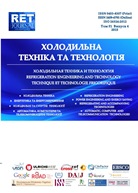SYSTEM OF COLD STORAGE USING BINARY ICE
DOI:
https://doi.org/10.15673/0453-8307.4/2015.44784Keywords:
system of cold storage, binary ice, peak loadAbstract
This paper reviews different types of systems of cold storage. The use of such systems due to the need of compensation of peak cooling loads by air conditioning of the large buildings or the technology requirements. According to the type of storage media and the way a storage medium is used water (the aqueous solution) and ice. When using standard systems of cold storage to the consumer is served single phase coolant. System with binary ice can bring to the consumer a two-phase coolant. Application of two-phase coolant when cooling improves energy and performance characteristics of the refrigeration system with accumulation of cold. It justifies the reasons for using binary ice as a coolant. Examples of large industrial facilities using cold accumulation with binary ice.References
Gang, Li, Yunho, Hwang. 2012. Review of cold storage materials for air conditioning application. International Journal of Refrigeration, June 2012, 2053−2077.
Zimin, О. V., Lar’yanovskii, S. Yu. K voprosu ispolzovaniya binarnogo l’da kak khladonositelya. Pross. of I International Scientific and Technical Conference "Kholod v energetytsi i na transporti: suchasni problem kondytsiyuvannya ta refryzheratsii" Part II. Mykolaiv, 5-6 November 2008, 255−260 (in Russian)
Freia, B. 2005. Characteristics of different pump types operating with ice slurry. International Journal of Refrigeration, January 2005, 92−97.
Kuriyama, T. 2001. Slurry ice transportation and cold distribution system. Information Booklet for the Technical Tour of the Fourth Workshop of IIR Ice Slurry Working Party, Nov 2001, 1−6.
Wang, M. J. 2001. Ice based thermal storage in multifunctional buildings. Heat Mass Transfer 37, 594−604.
Gladis, S. 1997. Ice slurry thermal energy storage for cheese process cooling. ASHRAE Trans 103, 725−729.


